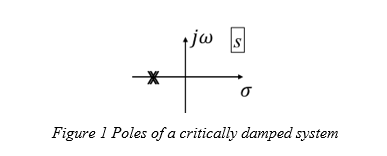EE123 Control Systems Report Assignment: Modelling & PID of Mass-Spring-Damper (MSD)
| University | Maynooth University (MU) |
| Subject | EE123 Electrical Engineering ( Introduction to Systems and Control ) |
ABSTRACT
The abstract is a short summary (100-200 words) of the key findings of your project. The abstract should explain to the reader why your report is important.
1 INTRODUCTION
The introduction chapter should introduce the project to the reader. Briefly explain the objectives and scope of your project.
2 THE MASS-SPRING-DAMPER IN ENGINEERING
This chapter should explain why the MSD is important in mechanical engineering. Give examples with diagrams/images and cite your sources. All figures should be numbered and captioned. Figure 1 shows an example.

3 MODELLING
This chapter should cover the modelling of your MSD plant. It should include a diagram of the physical plant, a free body diagram, a derivation of the differential equation model and a derivation of the Laplace transfer function model. Use the Equation Editor for all equations. Equations should be centred and numbered as follows (copy/paste the below line and edit the equation as needed):
![]()
You should describe your plant using system dynamic terms e.g. steady-state gain, order, damping.
3.1 Differential equation model
Derive the differential equation model using text/figures/equations.
Are You Searching Answer of this Question? Request Ireland Writers to Write a plagiarism Free Copy for You.
3.2 Laplace transfer function model
Derive the Laplace transfer function model using text/figures/equations/citations.
4 CONTROL SYSTEM
This chapter should explain the purpose of a control system and how we measure the performance of a control system.
4.1 Purpose of control
Explain the purpose of a control system using text/figures/equations.
4.2 Step response
Explain what a step response, and how we measure the transient and steady-state response using text/figures/equations.
4.3 Open-loop and closed-loop control
Explain open-loop and closed-loop control using text/figures/equations.
4.4 PID control
Explain PID control using text/figures/equations.
4.5 Zeigler-Nichols PID tuning
Explain the Zeigler-Nichols closed-loop (i.e. ultimate cycle) tuning method using text/figures/equations.
5 RESULTS
This chapter should use graphs and tables to present and discuss your results.
5.1 Simulink model
Describe your Simulink model using text/figures/equations.
5.2 Lab 4 results
Use graphs and tables to present and discuss your lab 4 results. Each result should be discussed.
5.3 PID tuning experiment
Describe your Zeigler-Nichols tuning experiment using text/figures/equations.
5.4 Simulink autotuning PID
Briefly describe your autotuning experiments using figures/text.
5.5 Tuned PID results
Use graphs and tables to present and discuss your tuned PID results (Zeigler-Nichols and autotuned). Each result should be discussed.
Get Solution of this Assessment. Hire Experts to solve this assignment for you Before Deadline.
5.6 Additional results
Include additional results here. Each result should be discussed.
6 CONCLUSIONS
List your main conclusions.
7 REFERENCES
Below is an example of a list of references. You should update this list with your own references. Each references should be cited at least once. Please watch this seven minute video to learn how to reference and cite: Referencing and citation for beginners
Get help with Control Systems Modelling Assignment Report for MSD from the professional homework helper of Ireland Assignment Help. Our writers are highly experienced and qualified and provide report writing services for MU students, so contact us if you need help, and you can also download a sample report from our website.

